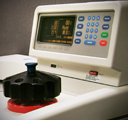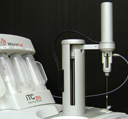The Quantitative Methods for Macromolecular Interactions (QMMI) Unit of the BEPS Shared Resource has expertise in:
- Characterization of individual macromolecules
- Characterization of interactions of macromolecules (self- and hetero association) and small ligands

QMMI is experienced in the application of a wide array of state-of-the-art biophysical instrumentation toward the characterization of individual macromolecules, as well as their interactions with other macromolecules or small ligands. This characterization may include:
- Determination of equilibrium binding constants
- thermodynamics (Delta G, Delta H, Delta Cp)
- kinetics (kon, koff)

- Measurement of solution-phase molecular weight, sedimentation coefficients, and translational diffusion coefficients, hydrodynamic radius, and overall asymmetry of macromolecules or their assemblies
- Establishment of the stoichiometry of complexes
- Insight into secondary structure or changes in structure upon ligand binding
The following analytical techniques are available within the QMMI Unit. Click here for pricing information.
Analytical ultracentrifugation (AUC) SV/SE
- Brown PH, Balbo A, Schuck P. On the analysis of sedimentation velocity in the study of protein complexes. Eur Biohpys J, 38, (8), 1079-1099, 2009.
- Balbo A, Zhao H, Brown PH, Schuck P. Assembly, loading, and alignment of an analytical ultracentrifuge sample cell. J Vis Exp, 33, pii 1530, 2009.
- Brown PH, Balbo A, and Schuck P. Characterizing protein-protein interactions by sedimentation velocity analytical ultracentrifugation. Current Protocols in Immunology, Chapter 18: Unit 18.15, 2008.
- Balbo A, Brown PH, Braswell EH, and Schuck P. Measuring protein-protein interactions by equilibrium sedimentation. Current Protocols in Immunology, Chapter 18: Unit 18.8, 2007.
- Lebowitz J, Lewis MS, Schuck P. Protein Science, 11:2067-2079, 2002.
Isothermal titration calorimetry (ITC)
- Jelesarov I and Bosshard HR. Journal of Molecular Recognition, 12:3-18, 1999.
- Pierce MM, Raman CS, Nall BT. Methods, 19:213-221, 1999.
- Velazquez-Campoy A, Leavitt, SA, Freire E. Methods in Molecular Biology, 261:35 -54, 2004.
Dynamic light scattering (DLS)
- Wyatt, PJ. Analytica Chimica Acta, 272:1-40, 1993. Surface Plasmon Resonance (SPR)
Surface Plasmon Resonance (SPR)
- Schuck P. Annu. Rev. Biophys. Biomol. Struct. 26: 541-566, 1997. For more information, see the Micro Analytical Immunochemistry SPR page.
Differential scanning calorimetry (DSC)
- Cooper AM, Nutley, A and Wadwood A. Differential scanning microcalorimetry. In Protein-ligand Interactions: hydrodynamics and calorimetry, pp. 287-318. Edited by S. E. Harding & B. Z. Chowdry, New York: Oxford University Press, 2000.
- Jelesarov I and Bosshard HR. Journal of Molecular Recognition, 12, 3-18, 1999.
Circular dichroism spectroscopy (CDS
- Kelly S and Price N. Current Protocols in Protein Science, 20.10.1 – 20.10.18, 2006.
- Kelly S, Ness, TJ, and Price, N. Biochimica et Biophysica Acta, 1751:119-139, 2005.
- Provencher SW and Glöckner J Biochemistry, 20:33-37, 1981
Asymmetric flow field-flow fractionation (AF4)
- Ratanathanawongs SK and Williams DL. J Sep Sci, 29:1720 – 1732, 2006.
- Fraunhofer W and Winter G. European Journal of Pharmaceutics and Biopharmaceutics, 58: 369-383, 2004.
- Fraunhofer W, Winter G, and Coester C. Anal Chem, 76:1909-1920, 2004.
Spectrofluorometry
- Lee, C. Y. 2009. Fluorescence Spectroscopy. Current Protocols Essential Laboratory Techniques. 2:2.4.1–2.4.29. DOI: 10.1002/9780470089941.et0204s02
